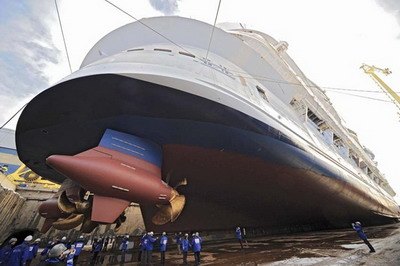Weird but wonderful
While learning naval architecture one of the most interesting thing in my opinion was the SWATH hull type.
original article : marine insight
SWATH ship is the abbreviated form of the word ‘Small Waterplane Area Twin Hull’ ship. Swath ships are designed in such a way that they have two or dual hulls instead of the conventional single hull. Technically, a swath ship is a type of a catamaran. The two hulls of the swath ship are built so as to offer the maximum amount of balance or buoyancy to the ship. The placement of the hull is such that it rests under the water surface, making it safer and easier for the ship to sail when high tides and fast currents hit with full force. Whereas in single hull ships or boats, the hull floats above the surface of the water which makes the sailing difficult especially during unpredictable and rough seas
The position of the hull under the surface of the water is also sometimes referred to being ‘submarine submerged’ as the technology looks similar to a submarine moving under the water. Along with the factor of buoyancy, a swath vessel is also known for its speed. Another feature and advantage of a swath vessel over the traditional ships is that it offers a bigger and wider area than the conventional types of ships.
link : http://marineinsight.com/marine/types-of-ships-marine/what-is-a-swath-ship/
New Propulsion System!
Azipod system used on ships is combination of both propulsion and steering systems. In conventional propulsion system, a large two stroke engine is connected to a shaft, which passes through shaft tunnel and stern tube and connects to the propeller outside the hull in the aft part of the ship. The steering of such system is done with the help of a rudder placed in the aft of the propeller.
However, in azipod arrangement, the propulsion and steering systems are combined and made into one part. The system consists of a propeller which is driven by an electrical motor and the propeller is turned by the rudder which is connected to the system.
The motor is placed inside the sealed pod and is connected to the propeller. It should be noted that the sealing of the pod should be perfect otherwise it can damage the whole motor and make the ship handicap from maneuvering. The motor used for this system is variable frequency electric motor. Using variable frequency, the rotational speed of the propeller can be controlled i.e. the speed can be increased or decreased.
The azipod system is also known as POD drive system, where POD stands for Propulsion with Outboard Electric motor. The whole azipod system is situated outside the hull in the aft of the ship. The azipod can turn in all the directions i.e. 360 degrees with the help of a rudder, and thus provides a thrust in any direction which is not possible in the conventional system. The propeller in the pod system is moved by the rudder which is placed in the steering flat, also the power module for the system.
Understanding the Azipod System
The azipod system is a type of electric propulsion system which consists of three main components:
1) Supply Transformer
The power produced from the generators is as high as 6600 KV, which is stepped down to the necessary voltage by the supply transformer required and is provided to the motor placed in the pod.
2) Propulsion motor
Propulsion motor is used to drive or to produce thrust. The system needs some method for rotating the propeller and this is done with the help of electric motor.
3) Frequency Controller/converter
This is used to change the frequency of the supplied power so that the rotating speed of the motor can be controlled depending on the requirement.
Advantages of Azipod System
1) Greater maneuverability as the propeller can be turned in all directions. This enables better stop distance during crash maneuvering than that provided by the conventional system.
2) In case of ships having large breadth, two or more azipods which are independent of each other can be used. This provides subtle maneuvering.
3) It saves a lot of space in the engine room as there is no engine, propeller, shafting and other arrangements. The saved space can thus be used for storing more cargo.
4) The system can be placed below the ship’s height thus providing more efficiency than the conventional system.
5) Use of side thruster is eliminated as the pods can be used for providing the side thrust.
6) Low noise and vibrations than the conventional system.
7) Low fuel and lube oil consumption.
8) Environment friendly as emissions are extremely low.
Disadvantages
1) Azipod system requires massive initial cost.
2) A large number of diesel generators are required for producing power.
3) There is a limitation to the power produced by the motor. As of now the maximum power available is 21 MW.
4) Cannot be installed in large ships with heavy cargo which need a lot of power and large motors.




